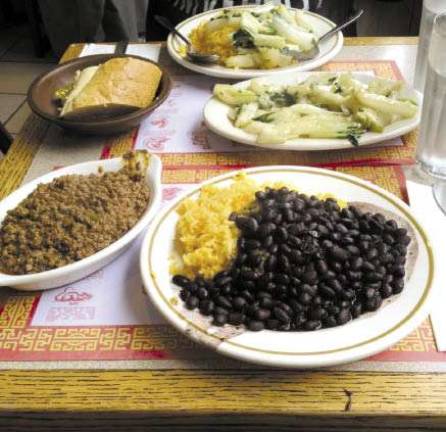Future of Chino-Cubano Restaurants Remains Uncertain

One of the city's lastholdouts of the fusion cuisine remains on the Upper West Side
On an unseasonably warm and misty fall afternoon, Michael Yip, 56, sits alone at the back of La Caridad 78, his family-owned restaurant since 1970, wiping down menus. He takes a break to gaze out the window and watch the crowds rushing along Broadway.
He then turns his attention to the restaurant floor, where half of the tables are occupied. As he returns to cleaning the menus, a waiter brings his lunch, a small bowl of sopa de wonton and a smaller portion of yellow rice and beans. Yip has managed this Chino-Cubano restaurant for 17 years and has witnessed the near disappearance of this once common cuisine that was born of cultural integration.
Chinese immigrants sent to work on sugar plantations in Cuba adapted the locally available food to their cuisine, creating a fusion of two cultures. Chinese and Cuban cuisines use many of the same foods as staples in their meals, such as pork and rice.
According to Los Culíes Chinos en Cuba, written by historical demographer Juan Pérez de la Riva, around 150,000 Chinese laborers migrated to Cuba in the late 1800s and by 1940, an estimated 30,000 to 40,000 were living there, primarily in Havana. The population grew so immense that Havana set up a 40-block radius known as El Barrio Chino ? better known as Havana's Chinatown. The area had an abundance of Chinese-owned restaurants and other businesses.
When rebels led by Fidel Castro ousted the government in 1959, small, privately owned businesses were nationalized, and many Chinese immigrants left Cuba. The majority migrated to New York and Florida, particularly Miami, where many opened small businesses, including restaurants that combined their native foods with the recipes they acquired in Cuba.
As the immigration population aged and few of their children remained in the restaurant business, Chino-Cubano food began to disappear. "They closed because we don't have a new generation coming over here from Cuba," said Yip, who moved with his family to New York City in 1970.
Chino-Cubano restaurants suffered because there hasn't been another surge of immigrants from the island in decades, said Laura Rodríguez, an associate professor of Latino and Hispanic Studies at New York University. Rodriguez said the last Chinese immigrants to arrive from Cuba came around 1959.
"Since the last wave of migration, their arrival to the States has come to a standstill," she said, "and the second and third generations don't want to take over the family-owned restaurants."
La Caridad's story is similar to many Chino-Cubano restaurants of the time. Yip's grandfather constructed and opened the restaurant himself. On its website, the restaurant says it serves the "working people's Cuban and Cantonese fare to its loyal patrons, who include taxi drivers, artists, cops, writers, and boisterous Hispanic families."
Yip said the restaurant thrived for two reasons. One was its location near the Beacon Theater and the comedy club Stand Up NY.
"It brings in a lot of tourists who want to try something different," Yip said.
The other reason: the family's determination to stay true to its roots. "We keep doing it the same way, like my grandfather did in Cuba, and we will keep doing it that way," he said. Yet, this doesn't mean that Yip isn't afraid that the restaurant's fate may follow those before it. "We do the best we can but one of these days, maybe when I'm gone, I think it will disappear," he said.
And Yip worries that Chino-Cubano culture will ultimately perish.
"I feel like it is more than just the food, but the spirit that is dying with it, the kids won't know about it anymore, but I'm glad this place is still around to keep that spirit alive," he said.
This story originally appeared on Baruch College's Dollars and Sense blog. Reprinted with permission.